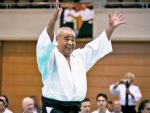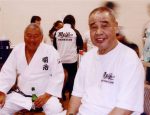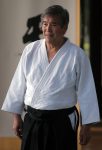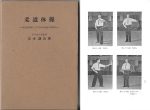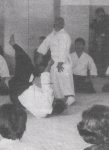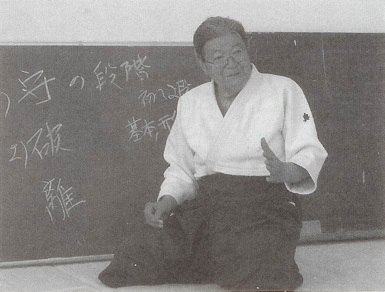
Shigenobu Okumura sensei in 1985 giving advice before promotion examinations
Take the initiative from the beginning. This is Aikido.
Shigenobu Okumura was one of the senior instructors at the post-war Aikikai Hombu dojo, and one of only a few Aikikai instructors to have started pre-war.
He was born in Otaru, Hokkaido in 1922, began Aikido in 1940 at Kenkoku Daigaku in Japanese occupied Manchuria with Kenji Tomiki, and passed away on August 12th 2008.
After the war he spent three years and eight months as a prisoner of war in Siberia before being repatriated to Japan.
Okumura sensei, perhaps partly because of his longstanding ties to Kenji Tomiki, acted as an intermediary between Tomiki sensei and the Ueshiba family during discussions concerning Tomiki sensei’s introduction of competition to Aikido, and often advised him to change the name of his art.
This is the second part of a two part English translation of an interview with Shigenobu Okumura sensei. You may wish to read part one of the interview before moving on to this section.
This interview was published in a collection of interviews with students of the Founder published in Japanese as 開祖の横顔 (“Profiles of the Founder”) in 2009. It originally appeared in the January 2008 issue of Gekkan Hiden (月刊秘伝 / “Secret Teachings Monthly”), a well known martial arts magazine in Japan.
There was a short introduction to this work in the article “Morihei Ueshiba – Profiles of the Founder“. I previously posted an English translation of interviews from that collection with Nobuyoshi Tamura sensei (Part 1 | Part 2), and Hiroshi Isoyama sensei (Part 1 | Part 2).
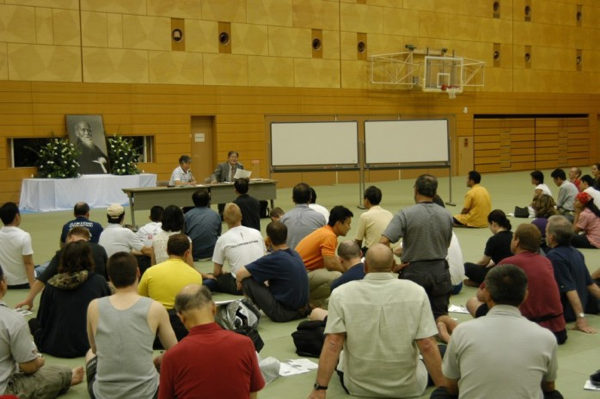
Shigenobu Okumura sensei’s lecture at the 9th International Aikido Federation congress
Interview with Aikido Shihan Shigenobu Okumura, Part 2
(translation by Christopher Li)
Q: This sounds like the Riai (“unified principles”) of the sword.
A: That’s because O-Sensei actively researched the sword. After the war Kisaburo Osawa-san (大澤喜三郎) and others went to learn Kashima Shinto-ryu (鹿島新當流). O-Sensei would say “What did you do today?”, watch what they had learned that day, and then explore various ways of using the sword in Aikido. While he was doing this he passed away.
Q: In a previous interview you said that you had seen such things as Sho-chiku-bai Sword (松竹梅の剣 / “Pine-bamboo-plum Sword”) and Gogyo Sword (五行の剣 / “Five Elements Sword”)…
A: I think that those things were still going through a period of trial and error. So Saito-san from Iwama and Sadao Takaoka-san (高岡貞夫) from Wakayama were used as practice partners during that process of trial and error. For that reason, my belief is that the sword of Aikido is incomplete. In the end, if you conflict with someone holding a weapon from the front you will be stabbed. That is why the effectiveness of “decide the encounter while passing by the opponent without conflict” was observed on the battlefield.
Struck by the Gods
Q: What left the greatest impression during your training with the Founder?
A: Simply by moving O-Sensei could touch a person’s spirit. That left a great impression on me. Just at the instant that he moved the spark in his eyes would shift. At that moment he was someone else. Also, his Kiai – “Eii~” – I remember a real tingling all the way to my navel at that voice. Hakudo Nakayama (中山博道) sensei’s Iai was also that way, I suppose that it was the power of concentration (*”shuchuryoku” / 集中力), it was really an incredible Kiai.
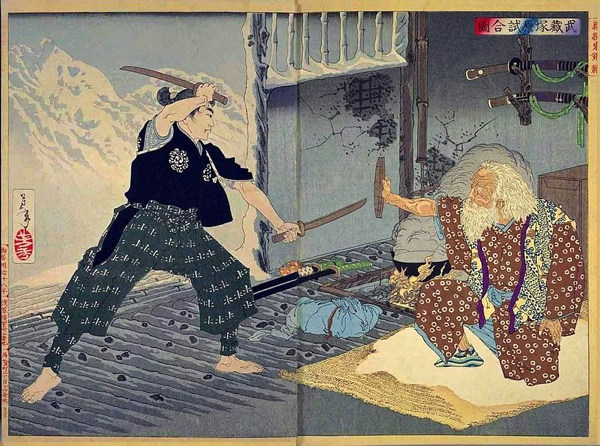
Kashima Shinto-ryu (鹿島新當流) Founder Tsukuhara Bokuden faces Miyamoto Musashi
Q: Is there something that he said that you especially remember?
A: “Irimi is Ichi-no-tachi, swords passing each other. Leap forward as the opponent inhales, apply technique with your exhalation”, I think. Also, the time spent on suwari-waza was very long and there wasn’t much free practice.
*”Ichi-no-tachi” / 一之太刀 is the first of twelve techniques in the Kashima Shinto-ryu curriculum, and virtually identical to an exercise taught to Morihiro Saito by Aikido Founder Morihei Ueshiba).
The term “Ichi-no-tachi” is also present in Kashima Shin-ryu (鹿島神流), a separate tradition that was established in the same geographical area as Kashima Shinto-ryu. In Kashima Shin-ryu “Ichi-no-tachi” is defined as a balanced application of the Fivefold Laws (五ヶ之法定): Motion and Stillness as One (“dosei ittai” / 動静一体), Origination and Manifestation as One (“kihatsu ittai” / 起発一体), Offense and Defense as One (“kobo ittai” / 攻防一体), Emptiness and Reality as One (“kyojitsu ittai” / 虚実一体), and Yin and Yang as One (“in-yo ittai” / 陰陽一体)
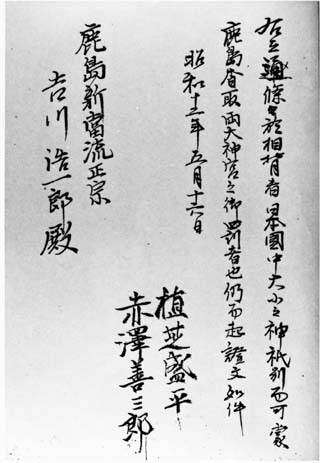
1937 Kashima Shinto-ryu Keppan (“blood oath”) signed by Morihei Ueshiba and Zenzaburo Akazawa
Q: There was no free practice?
A: We did it when O-Sensei wasn’t around, but he’d become angry at us if he found out so we’d stop before he came in.
Q: Why was that?
A: I guess that he thought that there was a danger that techniques would become distorted while he wasn’t looking.
Q: As I listen to you, I get a strong impression that wartime Aikido was “techniques for defeating the opponent” – quite different from now.
A: I believe that O-Sensei felt the same way. Of course, he hated the idea of “kill the opponent”. There are many ways to be victorious. Kill the opponent and win, injure the opponent and win, I believe that he thought that these were inferior methods of victory.
Q: So the ideal would be “win without injury”?
A: No. “Without conflict, victorious from the first instant”, by becoming one with the universe, by becoming one with the opponent, the opponent disappears – this is the condition that O-Sensei pursued with Aikido.
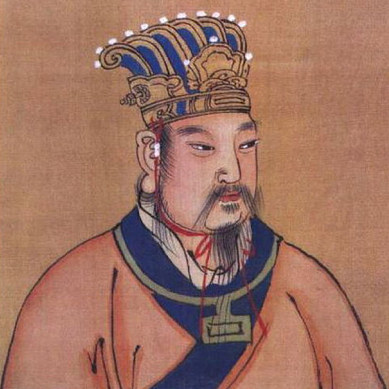
King Wen of Zhao (周文王 / 1152-1056 B.C.)
said to be the originator of the phrase “The Budo of the Gods does not kill” (神武不殺)
Q: The relationship between opponents disappears.
A: O-Sensei also followed the teachings of Omoto (Omoto-kyo), and there was something called “The Budo of the Gods does not kill” (“jinbu fusatsu” / 神武不殺). However, at that time he couldn’t say such things. At the university it was required that techniques “for killing” were taught, and of course the Military Police Corps (憲平隊) had to be taught Aikido for the purpose of throwing down the opponent. For that reason, when I was repatriated after the war and met O-Sensei, who was working in the fields of Iwama, he said “I was rebuked by the gods. They told me start over from the beginning! The Budo that kills is prohibited!”
Q: In your observation, was the pre-war era Founder different from the post-war era Founder?
A: Completely different. It’s not as if there was especially a sudden change from pre-war to post-war, but he moved from hard technique to soft technique. When I first met him he was 55 or 60 years old, so he still had physical power and may have over used it. It wasn’t like the movement in the dance of his twilight years. Just as in Shodo, where you move from square script to semi-cursive to cursive (楷書・行書・草書), it gradually crumbled away. The person most like the O-Sensei of Showa year 15 or 16 (1940-1941) is probably Gozo Shioda-san, the Yoshinkan. In the end, everybody is different depending upon the period that they were with O-Sensei. In his later years he reached the heights of the spiritual and his movements became soft.
There is only one kind of timing in Aikido
Q: When school was on vacation I have heard that you returned to Japan and stayed at Hombu Dojo.
A: That’s because there was nothing else to do after paying my respects at the cemetery. (laughing) At that time students could stay at the Dojo for free if they brought enough rice for themselves.
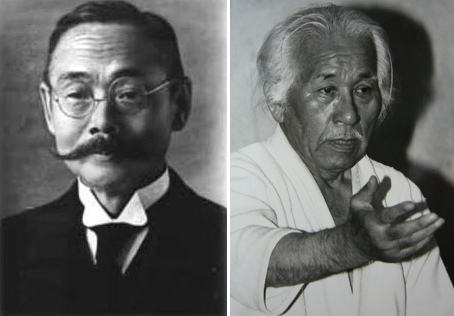
Kenzo Futaki (Misogi no Renseikai / 禊の錬成会) and Minoru Hirai (Korindo Aikido / 光輪洞合気道)
Q: What other people were at the Dojo at that time?
A: That was a time when the Uchi-deshi had been taken away by the war, so there weren’t many people there. Most of them died. Minoru Hirai-san (平井稔 / Founder of Korindo Aikido) was in the office, among the uchi-deshi was Matsumoto-san, and Dr. Kenzo Futaki (二木謙三 / Founder of the Misogi no Renseikai) was commuting. Futaki-san would wake me up at around 5:30 in the morning and we would participate in morning practice with O-Sensei.
Q: You were fortunate to have the chance to train with O-Sensei.
A: Yes I was, but this (Aikikai Hombu) training was different from the training at Kendai.
Q: How was it different?
A: Basically speaking, the training at Kendai was run by Tomiki sensei, so there was a lot of physical education type of training in being grasped strongly and escaping. Also, there were many people training, so we would move when only when our numbers were called out. Be that as it may, when I took ukemi after being thrown by O-Sensei at Hombu I thought “Ah, it’s different”.
Q: What was the content of the training?
A: He would also instruct the Military Police Corps, so of course there were many severe techniques. However, even those techniques weren’t rough. You would float away and be thrown.
Q: Are you talking about softness?
A: It’s different from softness. O-Sensei would say “It’s no good to be soft! In Aikido “acceptance” (素直さ) is important. Soft and accepting are different.”.
Q: Those are very important words, aren’t they?
A: In the end, if you are not accepting then you and the opponent can never become one. I think that Judo was also this way originally. In Budo you must have the acceptance to be like a “willow in the breeze”, receiving and flowing.
Q: So even in the so-called “square script” period there was no rough sense of conflict?
A: Of course, we couldn’t do that from the beginning, it became smooth after the rough conflict was digested. When a mother brought her daughter to meet O-Sensei and asked “This child has no strength, can she do Aikido?”, O-Sensei said “Can she lift chopsticks? If she can lift chopsticks then she can do Aikido”.
Q: Do you have any other memories?
A: Well, what I can’t understand even now was the feeling of his wrists. When you grabbed his wrist it felt as if you were somehow floating. When we were doing breath power training, even if I gripped him with all of my strength, it was just completely different. That feeling is still a mystery to me today.
Q: Was it softness?
A: It was different than softness. There was an elastic force, and even though I was grabbing it felt as if I was being grabbed…
Q: “Even though you were grabbing it felt as if you were being grabbed”?
A: O-Sensei told me “In Aikido, even if there is an opening (in the opponent), don’t leap into it”. It is said that the Samurai of old didn’t say “I was cut”, rather they said “I made them cut”. Aikido is the same – my hand is not grabbed, I make them grab my hand. Technique is the same, you make the opponent leap in and then take them.
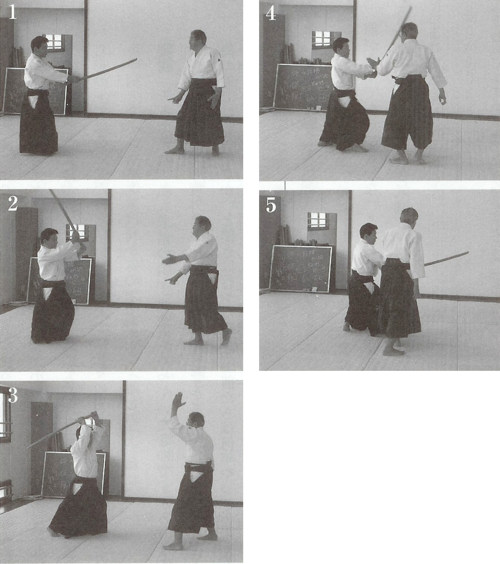
Taking the initiative in Irimi-Tenkan
“Don’t wait until something important happens and then move, don’t anticipate and move, call the opponent towards you. In other words, take the initiative from the beginning. This is Aikido.”
Shigenobu Okumura sensei
Q: Is this the same as “Go-no-sen” (後の先)?
A: No, it’s different. At first glance it appears to be “Go-no-sen”, but O-Sensei said “You cannot divide timing into three (“Sen-sen-no-sen” / 先先の先, “Tai-no-sen” / 対の先, “Go-no-sen” / 後の先). That’s no good for Aikido. There is only one kind of timing in Aikido, that is to always take the initiative.”. This is an area that is difficult to explain. It’s just that your psychological state is different. I was told “For that reason, Aikido does not have attacking techniques, they are unnecessary”. So, in my thinking it is that form appears to be “Go-no-sen”, but in your feeling it is “Sen-sen-no-sen”.
Q: I think that I see the nuance, but it’s very difficult, isn’t it?
A: Yes it is. Since I have been doing Kendo since I was a child it was hard to get rid of the habit of “Sen-no-sen”. One time, when I and Nao Sonoda-san (園田直), who was working at the Foreign Ministry, went to the Founder and asked “After all, is Go-no-sen really no good (for Aikido)?”, he scolded us, saying “How long have you been doing this?”. (laughing)
Treasure every encounter, for it will never recur – now is the end, this is the end
Q: In any case, from Manchuria up until now, you have been doing Aikido for a long time.
A: Yes I have. It’s been close to seventy years. Thanks to my language studies I was able to survive the military and my time in internment, there were many who did not survive.
Q: Could I ask again about the positive qualities of Aikido?
A: I suppose that it is different from sports, in a place beyond winning and losing, a method of forging a single body and mind. Because Budo is not just a method of moving your body. At the end is whether you live or die, your view of life and death. “What is death?” “Why were you born and where are you going?” Don’t you think that there are questions that even philosophers cannot answer clearly? It is a Budo that includes even such questions as these.
Q: Now there is a movement to introduce Budo into the school curriculum.
A: Yes, that’s right. However, there is still the question of “Who’s going to teach?”. Because right from the start the scientists at the Ministry of Education place Budo one step lower than Dance. (laughing)
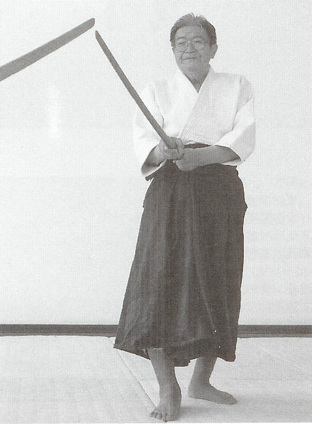
Shigenobu Okumura sensei explains Aikido through use of the sword
Q: Is that right?
A: In the past there was education of the spirit, education of the intellect, education of the physical, and education of morals (気育、知育、体育、徳育) – education of the spirit and the education of morals occurred through Budo. There are those mothers who will raise their eyebrows at the thought of a barbaric fighting method like Budo, but that’s not the way that it really is. Budo has shouldered the role of helping to develop our important characteristics as human beings. For that reason I would like Hiden Magazine to help raise up the place of Budo, and promote the ideal model of “The dual way of scholarship and the martial arts” (“bunbu ryodo” / 文武両道). (laughing) Even now I tell the students that budo is to treasure every encounter, for it will never recur – “Now is the end. This is the end”, and teach them to think about concepts such as “Shu-Ha-Ri” (守・破・離).
Q: This type of education existed in the era in which you were raised.
A: Of course, and that’s partially because it was that kind of a time. However, there were also certainly important things that were cultivated during that time. I would like to transmit those things to the future.
Gekkan HIden January 2008
Christopher Li – Honolulu, HI

